Are you interested in starting a flower garden but don’t know which easy flowers to choose? This blog post will tell you what plants are best for beginners, so you won’t have to worry about having a bad garden again!
I remember when I first started my garden twelve years ago. It was so exciting, and I had so many plans and ideas. For a gardener with little experience, the only problem was that I had no idea what flowers to plant.
I made some major faux pas in the beginning of my gardening career because I didn’t start with flowers that were simple to grow. These plants don’t take much to keep alive and thriving. Once you get more gardening experience and confidence, you can move on to more challenging flowers to grow.
As an Amazon affiliate, I earn from qualifying purchases at no extra cost to you. My blog contains other affiliate links for your convenience as well. Click here to read my privacy policy.
Starting a garden for the first time can be an exciting yet daunting endeavor. With so many plants to choose from, it can be overwhelming trying to decide what to grow The key is selecting crops that are not only productive and tasty but also easy to care for
As a beginner gardener, you want plants that are low maintenance, forgiving, and provide high yields. Certain vegetables, herbs, and flowers thrive with minimal effort, making them ideal for novice gardeners.
Here are the top 10 best plants for beginner gardeners:
1. Basil
A must-have for any herb garden, basil is one of the easiest herbs to grow. It thrives in full sun and well-drained soil. Basil is versatile and can be grown indoors or outdoors. It’s also quick to harvest, allowing beginners to enjoy fresh basil leaves in their summer recipes.
2. Mint
Known for its fresh, aromatic flavor, mint is a hardy perennial that often spreads aggressively. This makes it a great option for beginners since it requires minimal care once established. Mint thrives in moist soil and full to partial sunlight.
3. Sunflowers
A garden classic, sunflowers are one of the fastest and easiest flowers to grow. Their large seeds can be directly sown in the garden. Sunflowers are drought-tolerant and attract pollinators. Giant sunflower varieties can grow up to 12 feet tall!
4. Radishes
Perfect for impatient gardeners, radishes mature in just 3-4 weeks. They grow well in containers and raised beds, making them ideal for small spaces Radishes prefer cool weather and moist soil. Sow seeds every 2-3 weeks for a continuous harvest
5. Potatoes
Potatoes produce high yields with minimal effort. Plant seed potatoes in spring once the soil reaches 45-50°F. Potatoes thrive in loose, fertile soil that drains well. Simply mound soil around the plants as they grow. Harvest new potatoes in summer or cure mature potatoes for winter storage.
6. Spinach
A superfood powerhouse, spinach is one of the most foolproof leafy greens for beginners. It grows quickly in spring and fall, matures in 45 days, and thrives in cool weather. Spinach prefers nitrogen-rich soil and consistent moisture. Pick leaves once they reach 3-6 inches.
7. Marigolds
No garden should be without these colorful, hardy annuals that bloom nonstop from spring to fall. Marigolds have few pest problems and help deter nematodes. They grow well in average soil and full sun. Marigolds can be grown from seeds or transplants.
8. Zucchini
Among the easiest vegetables to grow, zucchini flourishes with minimal care. Each plant can produce a dozen or more fruits throughout the season. Zucchini prefers rich, moist soil and consistent watering. Just be sure to harvest regularly once they start ripening.
9. Green Beans
A garden favorite, green beans require little maintenance while producing high yields. Bush varieties grow well in containers and small spaces. Pole beans need trellising but yield more over an extended harvest. Sow seeds directly in the garden after the last spring frost.
10. Cherry Tomatoes
Perfect for beginners, cherry tomatoes ripen early and produce throughout the summer. Compared to large beefsteak varieties, cherry tomatoes rarely need staking and have fewer pest issues. They thrive in small spaces like hanging baskets and window boxes.
When you’re just starting out, select plants that are naturally vigorous and resilient. Focus on crops that suit your growing conditions and available space. With the right plants, you’ll be harvesting bountiful crops before you know it!

Black-Eyed Susans (Rudbeckia)
People who are just starting to garden often choose black-eyed Susans, which have bright yellow flowers with a dark brown center.
Their bright color livens up your summer garden while attracting pollinators such as bees and butterflies. Black-eyed Susans also make excellent cut flowers for arrangements.
Once established, they are easy plants that can thrive in poor soil and drought conditions.
| Typical Bloom Time | early summer to fall |
| USDA Hardiness Zone | 3-9 |
| Sunlight Requirements | 6 hours of direct sunlight daily |
| Height | 1 and 3 feet tall, with some varieties reaching up to 4 feet. |
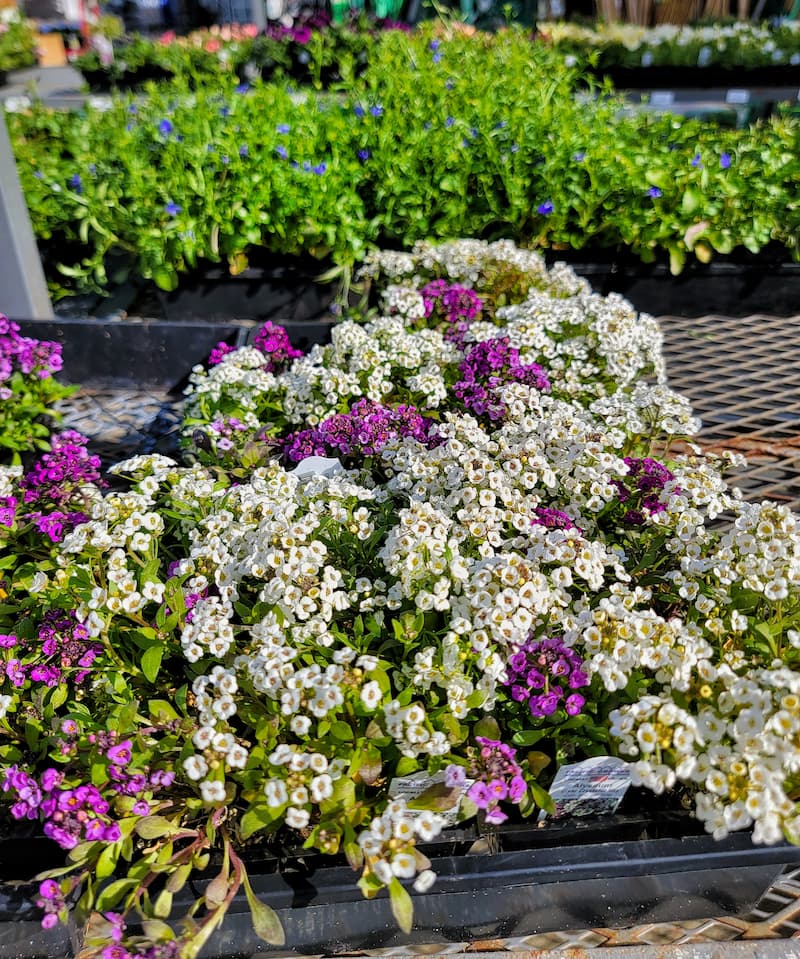
My favorite thing about this plant is its honey-scented flowers, which attract beneficial insects. Sweet alyssum can be grown in rock gardens, garden borders, and hanging baskets. Its blooms look beautiful as they spill over the edges.
| Typical Bloom Time | spring through fall; can continue to flower through the winter in milder climates |
| USDA Hardiness Zone | 9-11 |
| Sunlight Requirements | prefers full sun but will tolerate partial shade, especially in hotter climates |
| Height | typically reaching heights of 4 to 6 inches, but it can spread up to 9-12 inches wide |
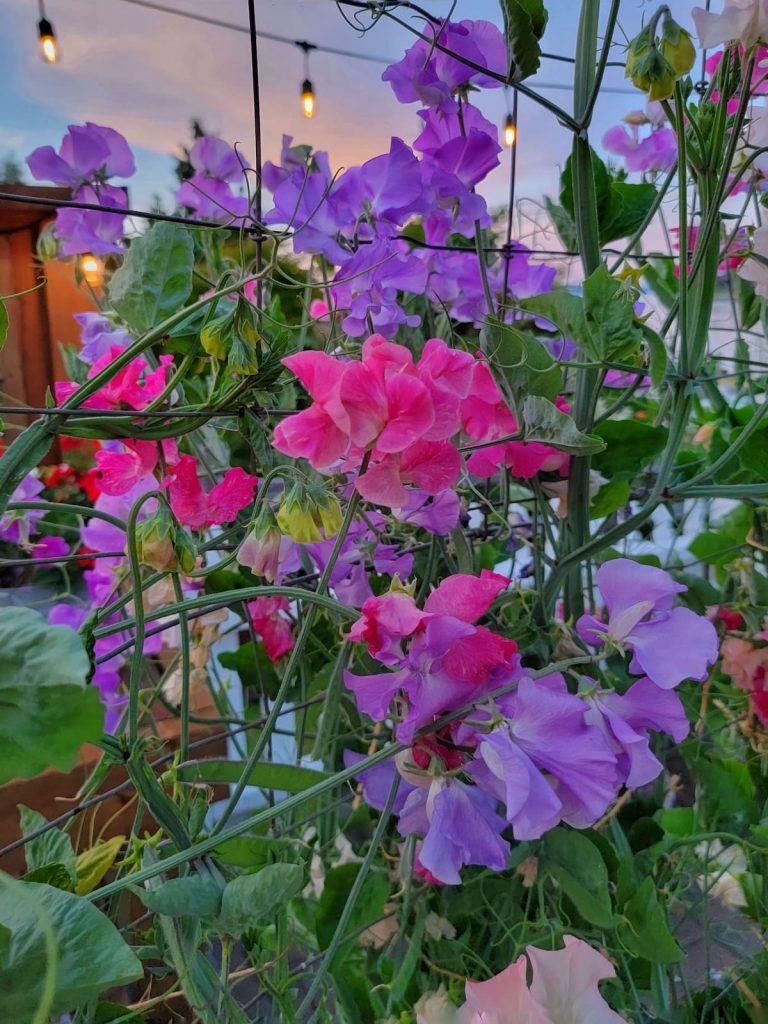
One of my garden favorites is fragrant sweet peas, which make excellent cut flowers. They’re climbing flowers that can be grown on trellises or arbors.
There are many different varieties with the most gorgeous shades of pink, white, purple, and more.
Sweet peas have a shorter growing season, but regular watering and cooler temperatures help prolong their blooming time.
| Typical Bloom Time | late spring and early summer |
| USDA Hardiness Zone | 2-11 |
| Sunlight Requirements | 6 hours of direct sunlight daily. |
| Height | can reach heights of 6 feet or more if provided with adequate support such as trellises or fences |
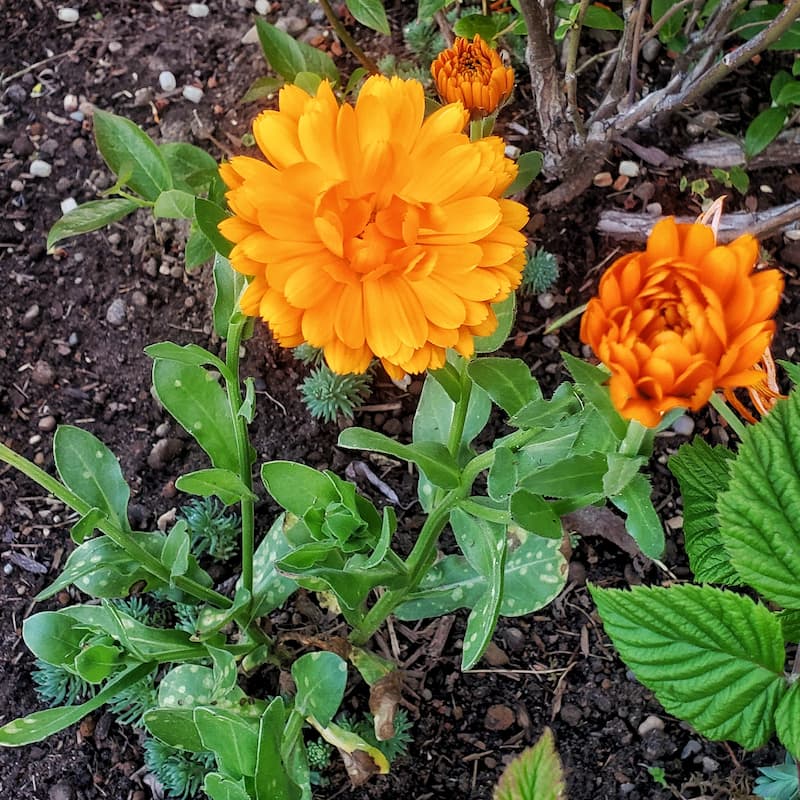
Calendulas are known for their bright, cheerful flowers ranging from bright yellow to deep orange.
Calendulas are easy to grow from seeds and often spread themselves, which makes them a low-maintenance way to add color to your garden. They are edible and commonly used as a decorative garnish in salads and other dishes.
| Typical Bloom Time | early spring through fall; can continue to bloom through the winter in mild winter climates |
| USDA Hardiness Zone | 2-11; they can tolerate a bit of frost |
| Sunlight Requirements | prefer full sun but can tolerate partial shade, especially in hotter climates for protection from the intense afternoon sun. |
| Height | 1 to 2 feet tall |
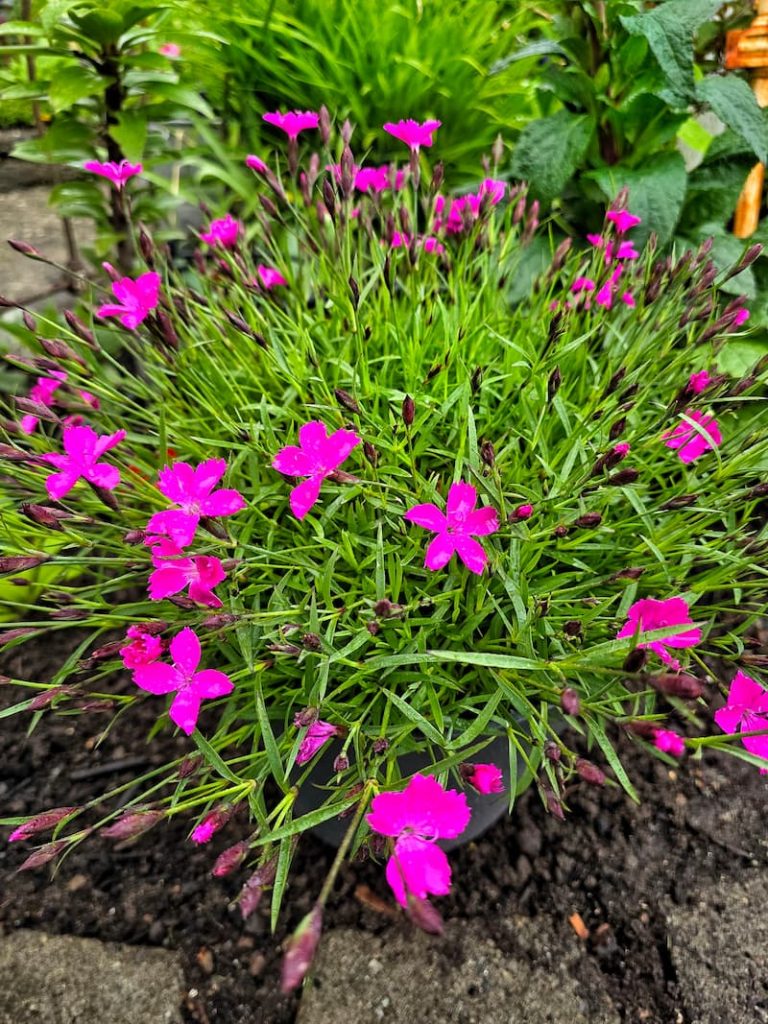
These fragrant, frilled flowers come in shades of pink, red, and white.
Dianthuses are popular in rock gardens, borders, and edging plants. Their long-lasting cut flowers are excellent for arrangements.
| Typical Bloom Time | late spring to early summer; many varieties will continue to bloom intermittently throughout the summer and into the fall if deadheaded regularly |
| USDA Hardiness Zone | 3-9 |
| Sunlight Requirements | 6 hours of direct sunlight daily |
| Height | 6 inches to 2 feet tall |
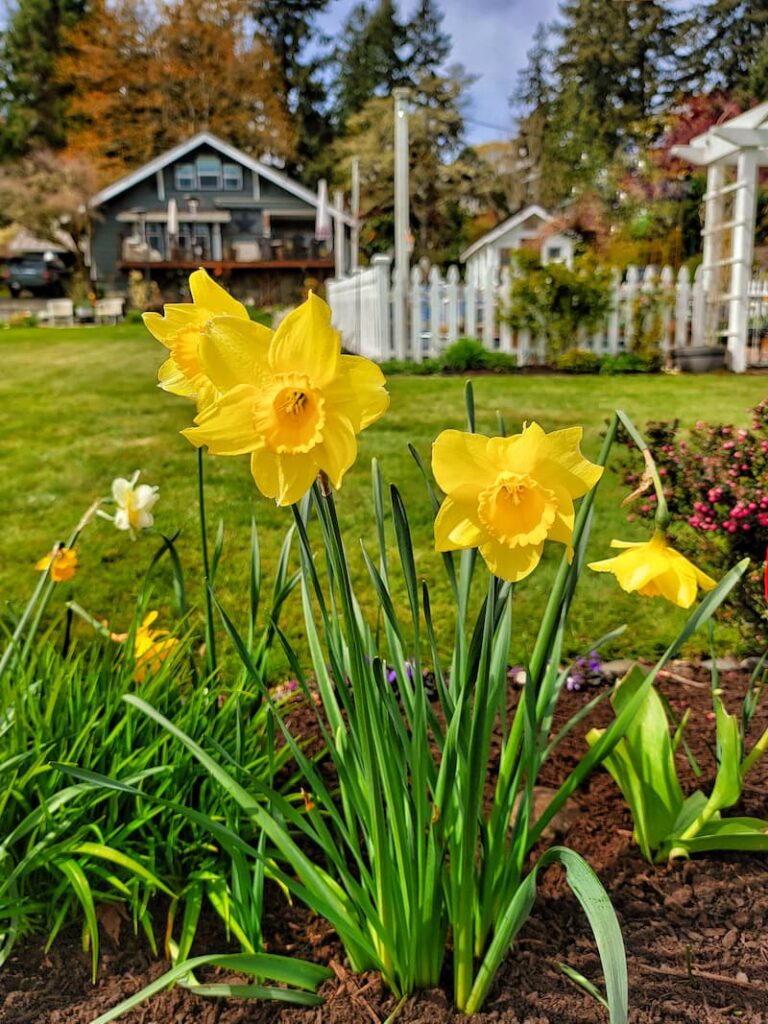
Can you think of a more happy and bright spring flower than a daffodil? These garden plants bloom right when we need them in the beginning of spring. And they’re among the few flowers growing in the garden even before the last frost date.
Daffodils come in shades of yellow, white, orange, and pink. They do well in lawns, along borders, and in wooded areas because they tend to grow quickly and come back every year with little care.
| Typical Bloom Time | early to mid-spring; they can start blooming as early as late winter in some regions |
| USDA Hardiness Zone | 3-9; they require a period of cold dormancy |
| Sunlight Requirements | 6 hours of direct sunlight daily |
| Height | 6 inches to 2 feet tall |
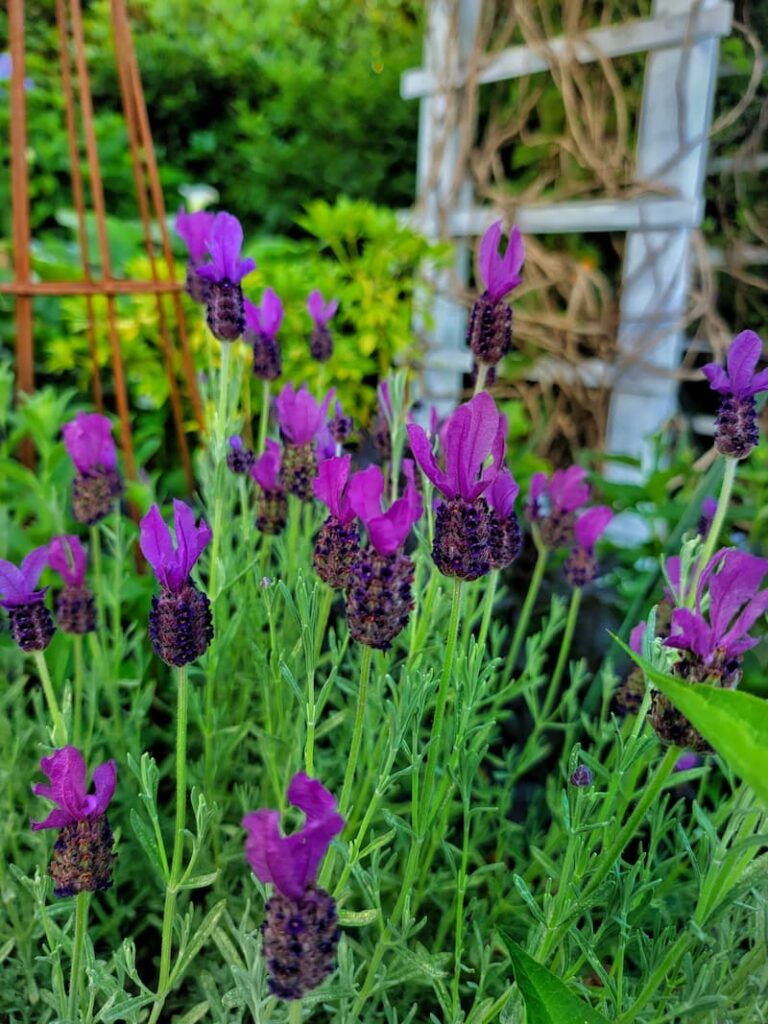
Some people love the smell of lavender plants, while others love all the ways they can be used, like in cooking, crafts, and herbal remedies.
Once established, this full-sun perennial prefers well-drained soil and minimal watering.
| Typical Bloom Time | late spring to early summer |
| USDA Hardiness Zone | USDA hardiness zones 5-9 |
| Sunlight Requirements | at least 6-8 hours of direct sunlight each day. The intense sun helps to develop the oils that give lavender its fragrance and flavor. |
| Height | can range from about 1 to 3 feet in height. |
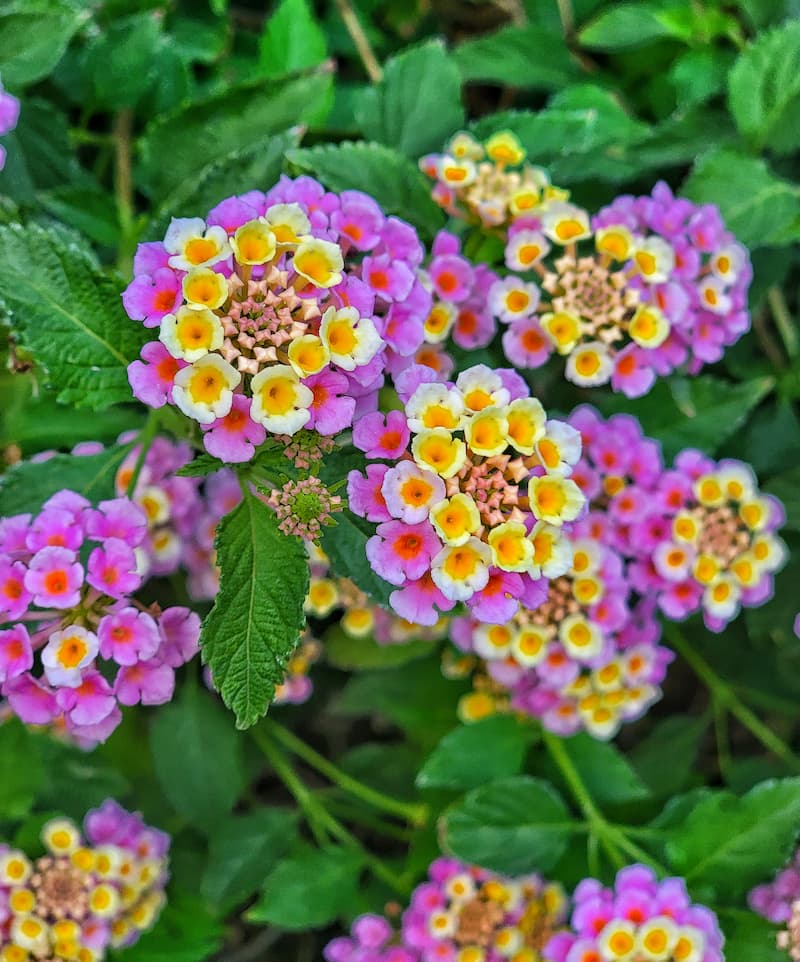
Lantana is popular because its multicolored clusters of flowers attract butterflies and other pollinators.
It can handle drought and grow well in poor soil, making it a low-maintenance choice for tough growing conditions.
| Typical Bloom Time | continuously from spring through fall |
| USDA Hardiness Zone | 9-11 as a perennial; can be grown as an annual in cooler climates |
| Sunlight Requirements | 6-8 hours of direct sunlight daily |
| Height | some groundcover types stay around 1 foot tall, while bushier forms can grow up to 6 feet in height if not pruned back |
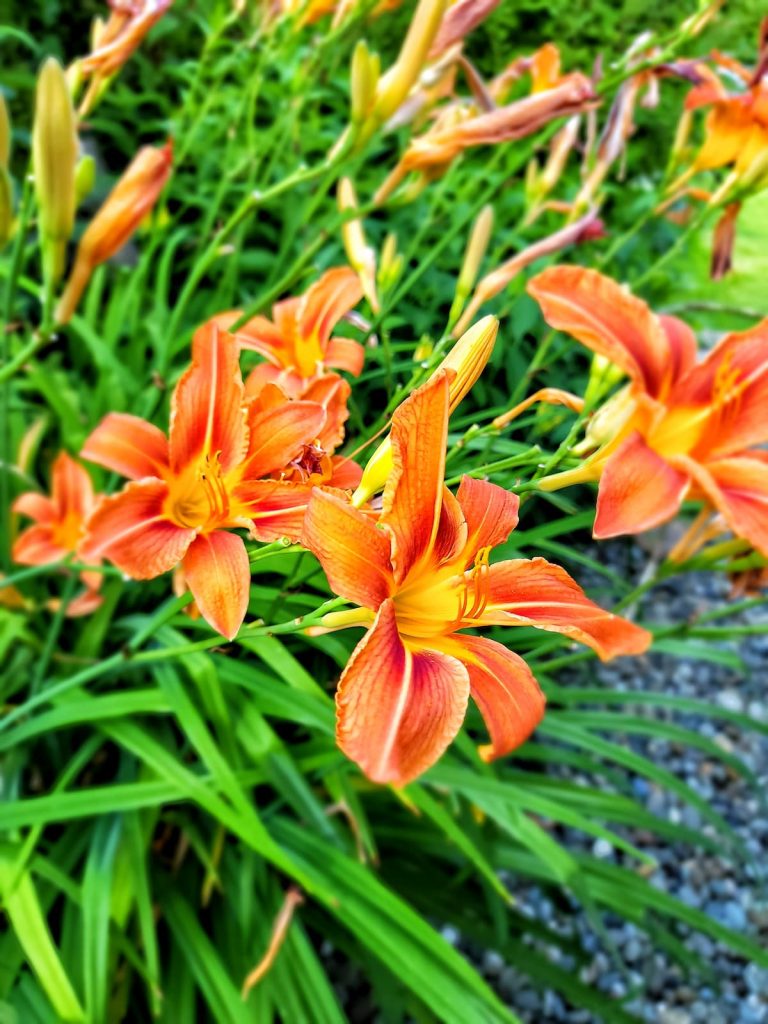
Daylilies are loved for their vibrant blooms and ease of care. Once established, they are extremely versatile, drought-tolerant, and excellent for mass planting, borders, and ground cover.
Daylilies have edible flowers that can add a colorful touch to salads and desserts.
| Typical Bloom Time | early summer to mid-summer; some varieties are known as rebloomers, providing a second round of flowers later in the season |
| USDA Hardiness Zone | 3-9 |
| Sunlight Requirements | 6 hours of direct sunlight daily |
| Height | 1 to 4 feet |
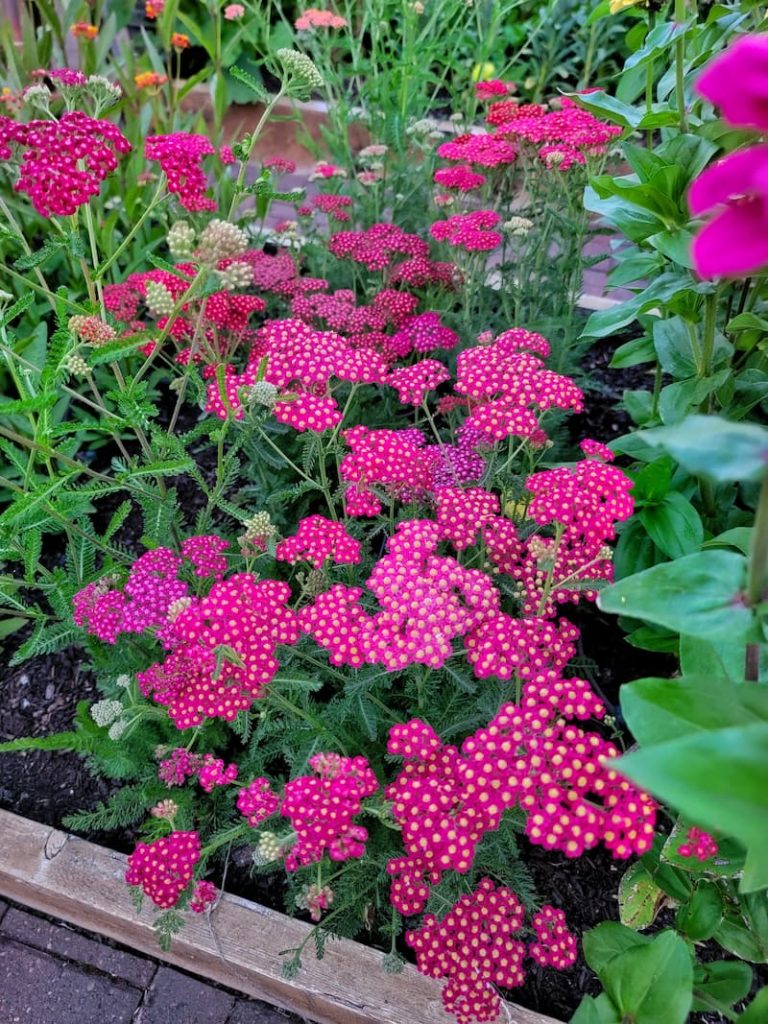
As a filler in garden beds and in wildflower meadows, yarrow is often used because it grows in a dense mat-like fashion. The fern-like leaves of yarrow are my favorite thing about it. They make my cut flower garden so much more interesting.
This whimsical garden flower is also known for its medicinal properties and is used in herbal remedies.
| Typical Bloom Time | early summer to early fall |
| USDA Hardiness Zone | 3-9 |
| Sunlight Requirements | 6-8 hours of direct sunlight daily |
| Height | 2 to 3 feet |
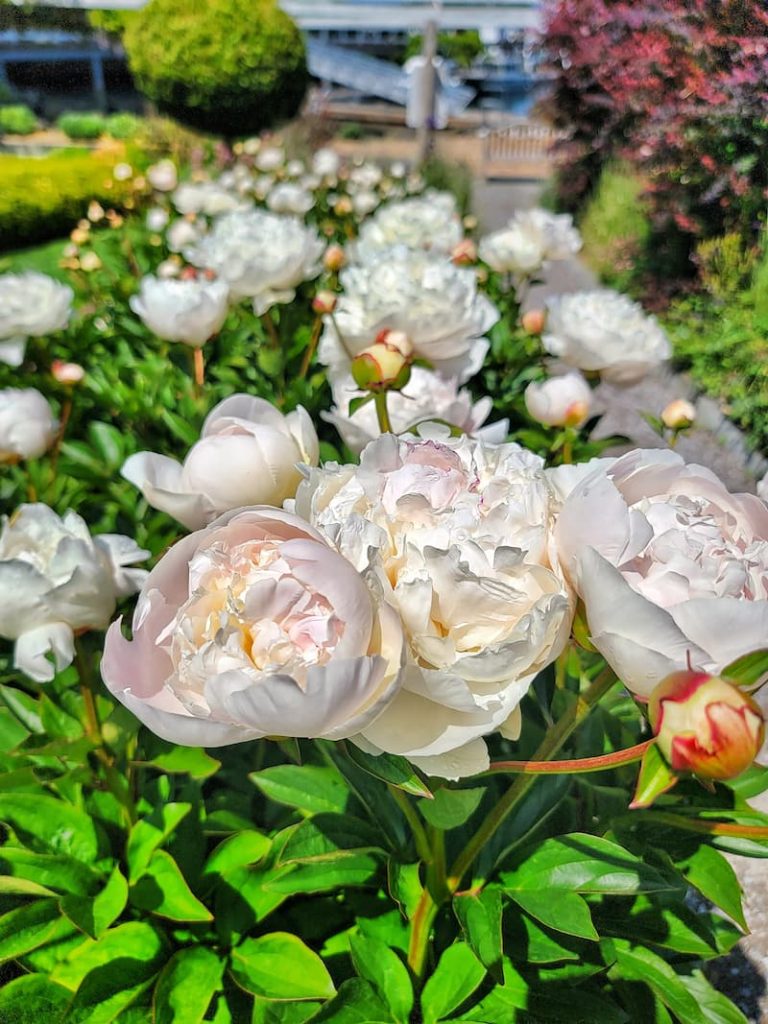
These long-lived perennials can bloom for decades with minimal care. You won’t have to move them for many years, though, and they do best in rich, well-drained soil.
Peony perennial flowers have beautiful, big, lush blooms that often smell great. They look great in gardens and bouquets.
| Typical Bloom Time | late spring to early summer; each variety has a relatively brief bloom period, lasting about 7-10 days |
| USDA Hardiness Zone | 3-8; they require a cold period during the winter to bloom successfully and may not perform well in regions without a significant winter chill |
| Sunlight Requirements | 6 hours of direct sunlight daily. |
| Height | most herbaceous peonies range from 2 to 3 feet tall; tree peonies, which are woody shrubs, can reach heights of 4 to 7 feet |
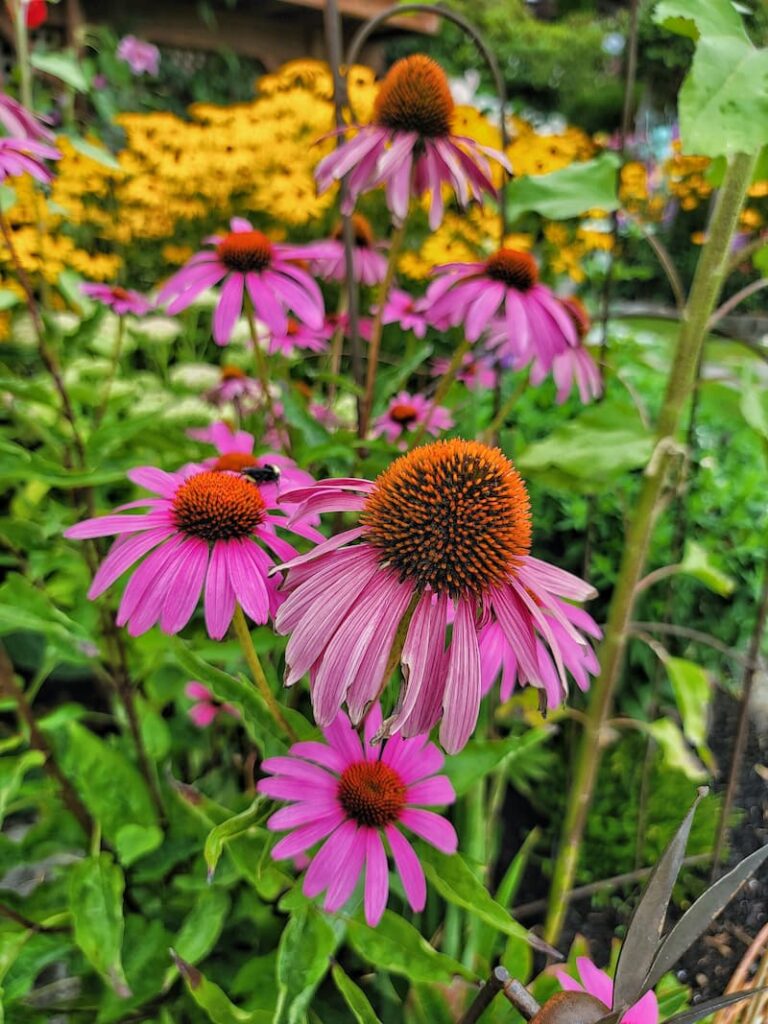
Another perennial plant I cannot live without is the coneflower or echinacea. Pollinators like bees and butterflies are drawn to their bright, daisy-like flowers with raised centers. They also make great cut flowers for bouquets.
They have a sturdy, upright habit that does not usually require staking, making them even more low-maintenance.
Coneflowers are also used in herbal remedies, particularly Echinacea purpurea, which is noted for its immune-boosting properties.
LET’S GO SHOPPING FOR
| Typical Bloom Time | early summer to late summer or early fall |
| USDA Hardiness Zone | 3-9 |
| Sunlight Requirements | 6 hours of direct sunlight daily |
| Height | 2 to 4 feet |
Best Flowers for Full Sun
Flower beds that get at least 6 to 8 hours of direct sunlight every day are great for plants that do well in full sun. Here are some of the easiest and best flowers for full sun:
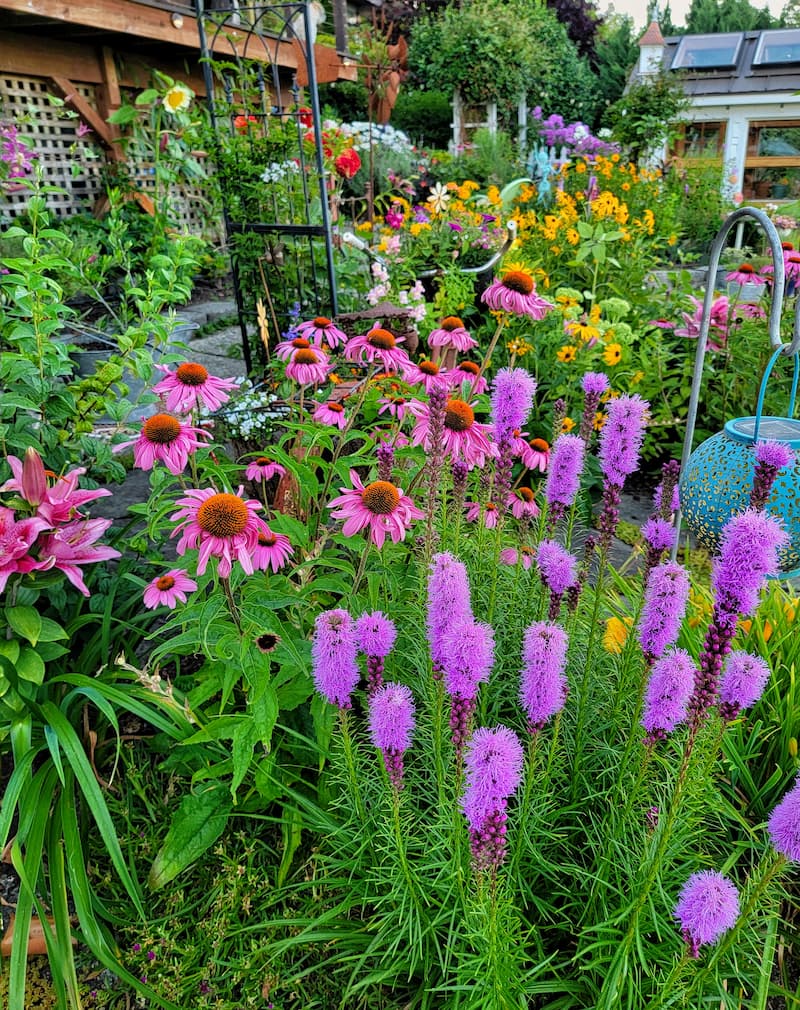
9 Plants You Should ALWAYS Grow
FAQ
What are good starter garden plants?
What is the first thing a gardener plants in the garden?
What is the first thing I should plant in my garden?
What is the best plant for beginners?
Garden Designer Raine Clarke-Wills of Raine Garden Design says it’s without a doubt the very best plant for beginners. This invaluable plant gives so much back, not only to encourage wildlife, but for endless color in the garden between May, right through to December, she continues.
What are the best houseplants for beginners?
You’ve got this. Below, learn about nine of the best houseplants for beginners, according to experts. If you’re looking to add a pop of color to your space, Lindsay Pangborn, a plant expert at Bloomscape, recommends the flowering bromeliad.
What vegetables are good for a beginner garden?
With their preference for slightly acidic soil, peas are an ideal addition to any beginner garden, offering a delicious and nutritious option for your plate. From steaming them as a side dish to adding them to soups and salads, peas are sure to become a household favorite in no time. 7. Carrots
Are Houseplants good for beginners?
If you’re looking to start a houseplant collection and haven’t developed your green thumb yet, some plants are better than others. Houseplants for beginners are easy to grow and generally withstand erratic watering, uneven or bad light, and fluctuating temperatures. They thrive in dorm rooms, offices, and sometimes even dismal corners.
Is lettuce a good plant for beginners?
Lettuce is a popular choice for beginner gardeners due to its fast-growing nature and low maintenance requirements. This leafy green can be easily grown in both garden beds and containers, making it a versatile option for any gardening space. As long as it has access to loose soil, only a little sunlight, and regular watering, lettuce will thrive.
Are Houseplants easy to grow?
Houseplants for beginners are easy to grow and generally withstand erratic watering, uneven or bad light, and fluctuating temperatures. They thrive in dorm rooms, offices, and sometimes even dismal corners. Here is a selection of the best beginner houseplants to help you get started.
- A Complete Guide to Caring for Yuki Cherry Blossom Shrub - January 23, 2025
- Identifying Red Hot Poker Seeds: What to Look For When Harvesting Torch Lily Pods - January 23, 2025
- A Complete Guide to Harvesting Evening Primrose Seeds - January 23, 2025
